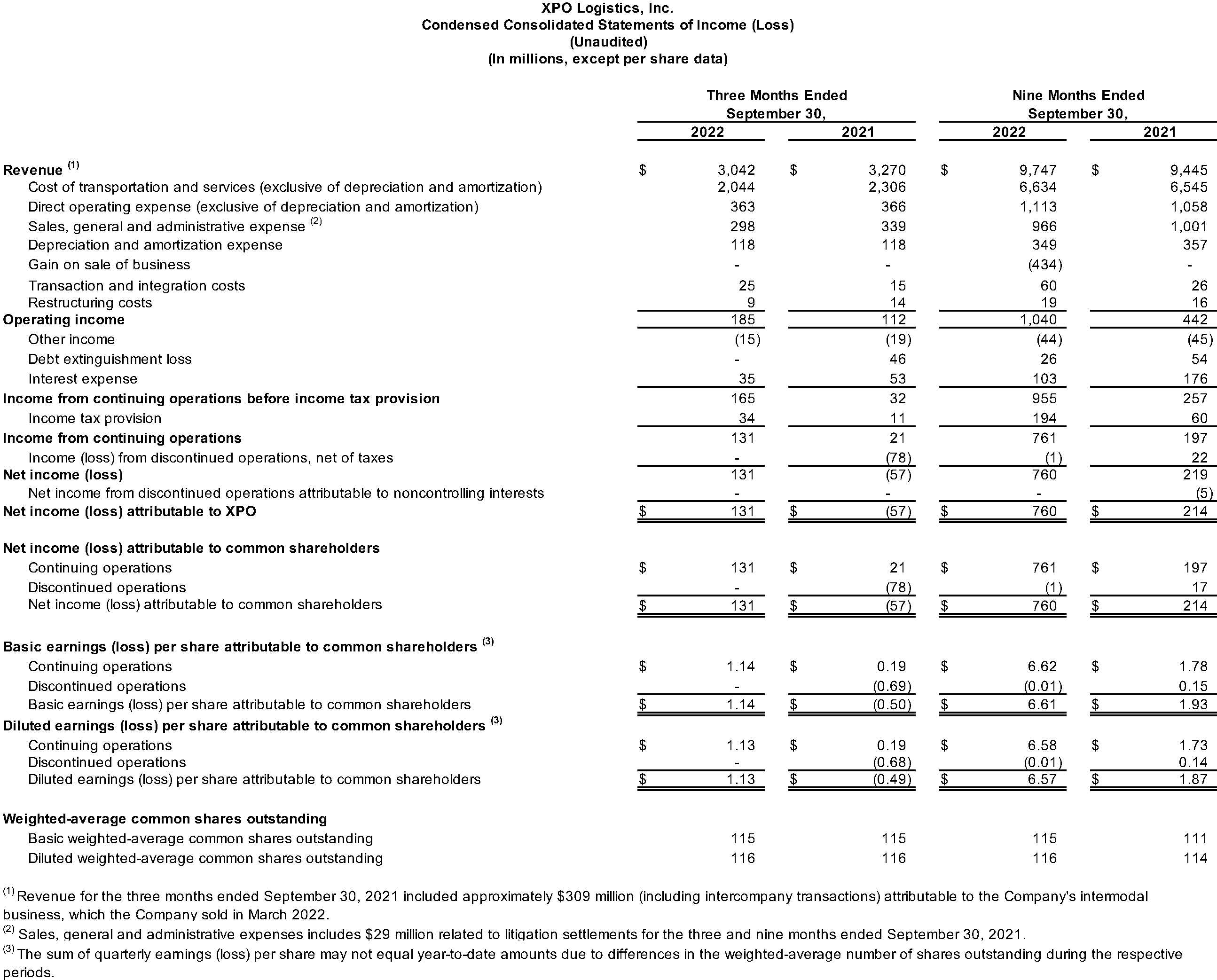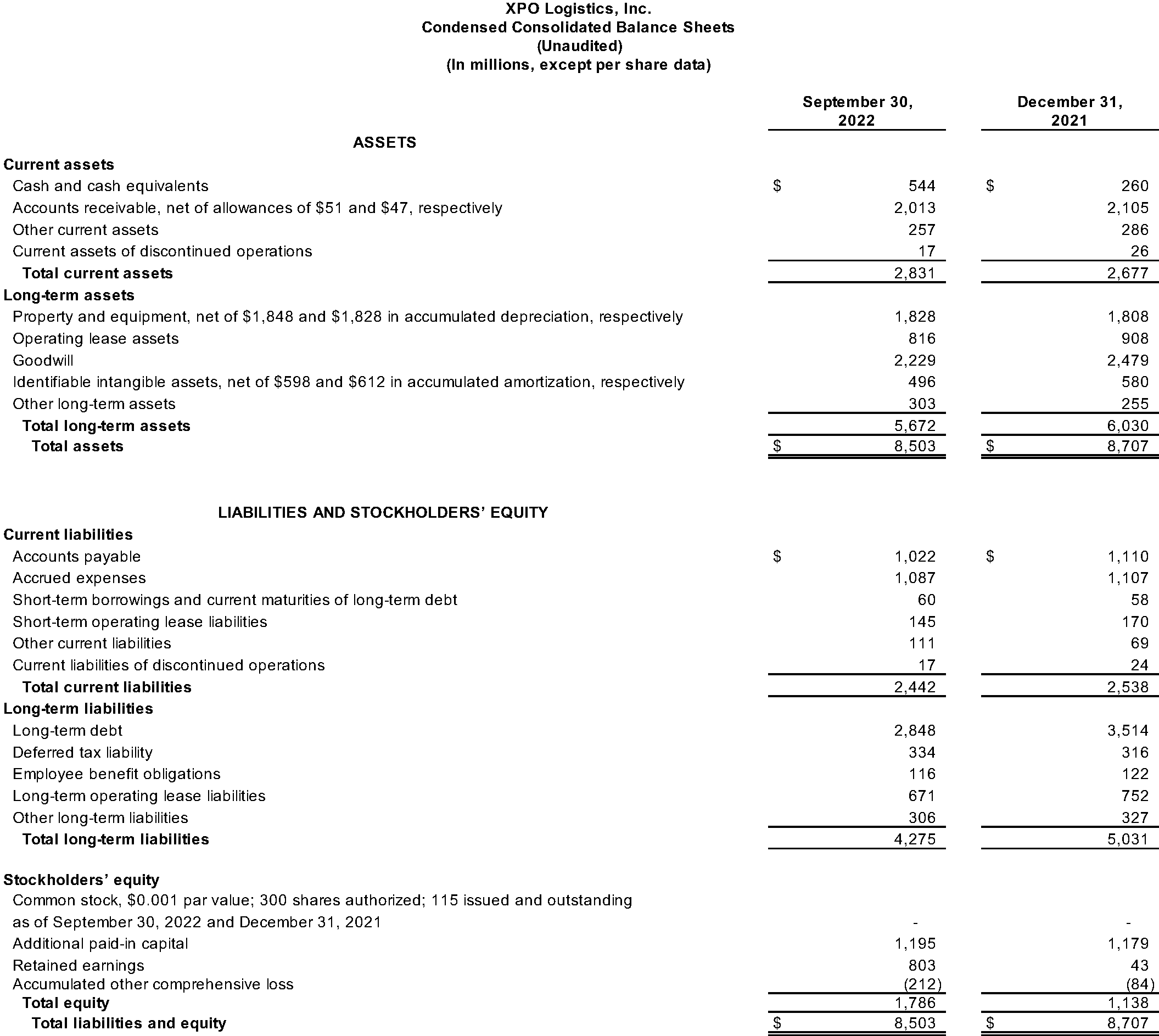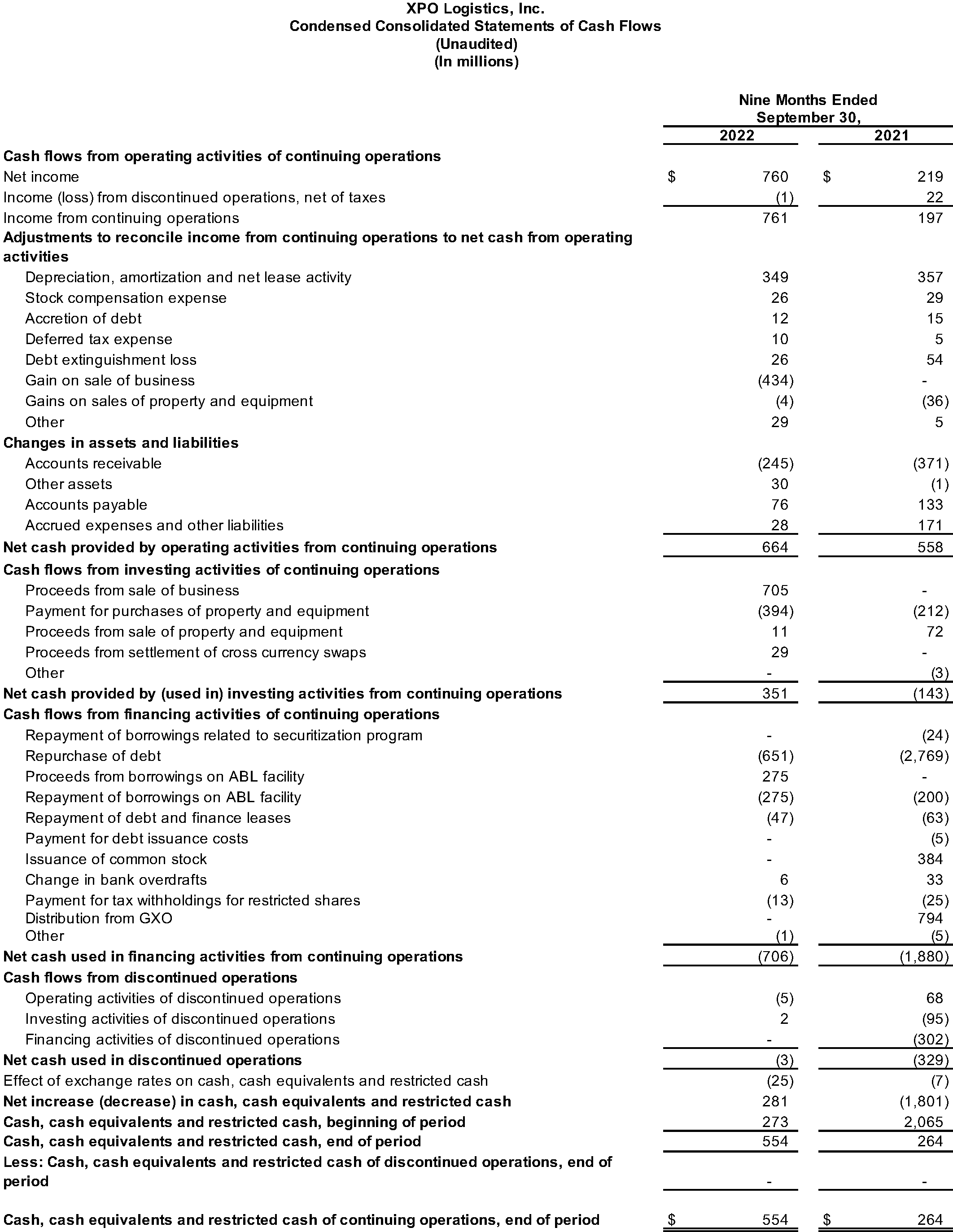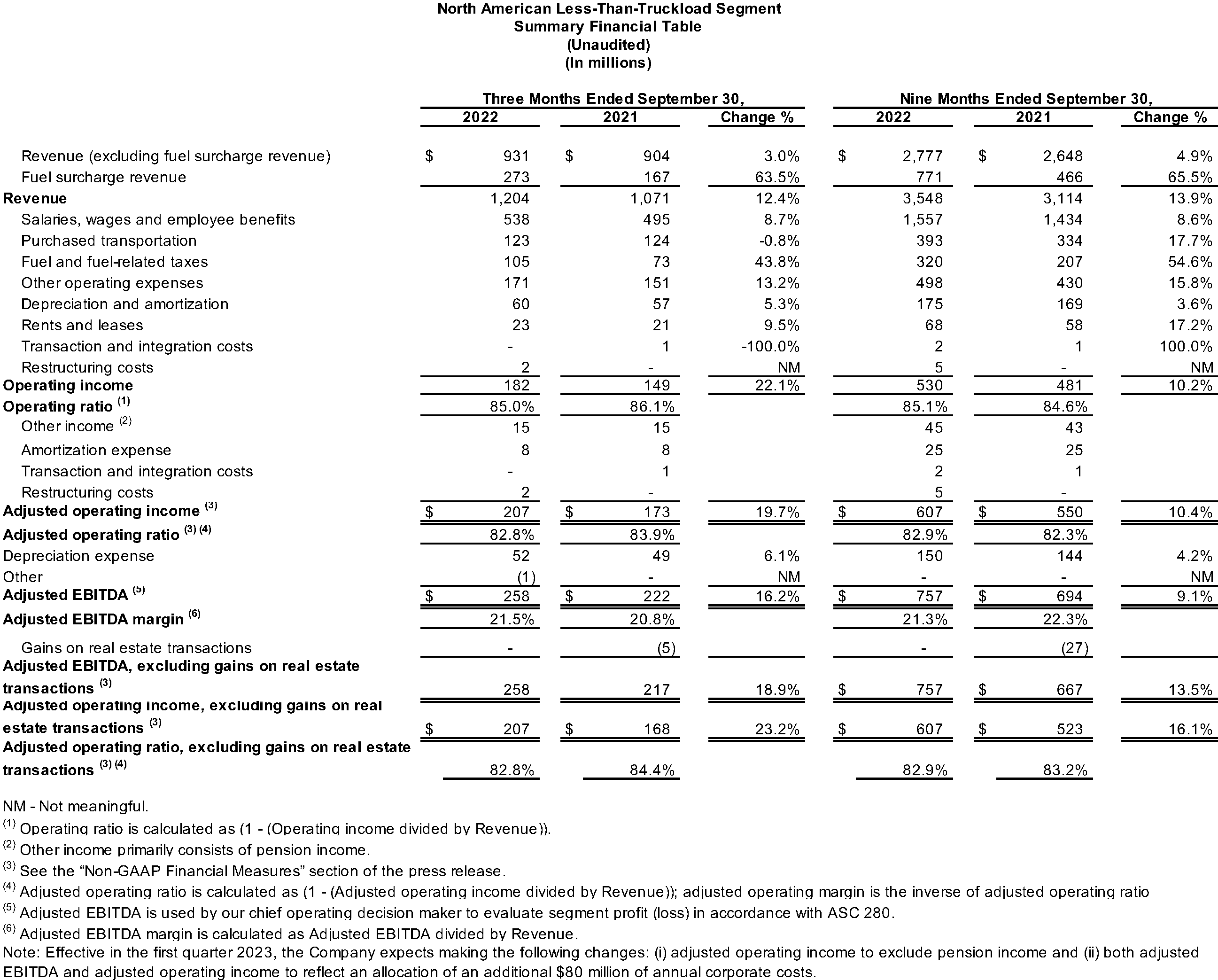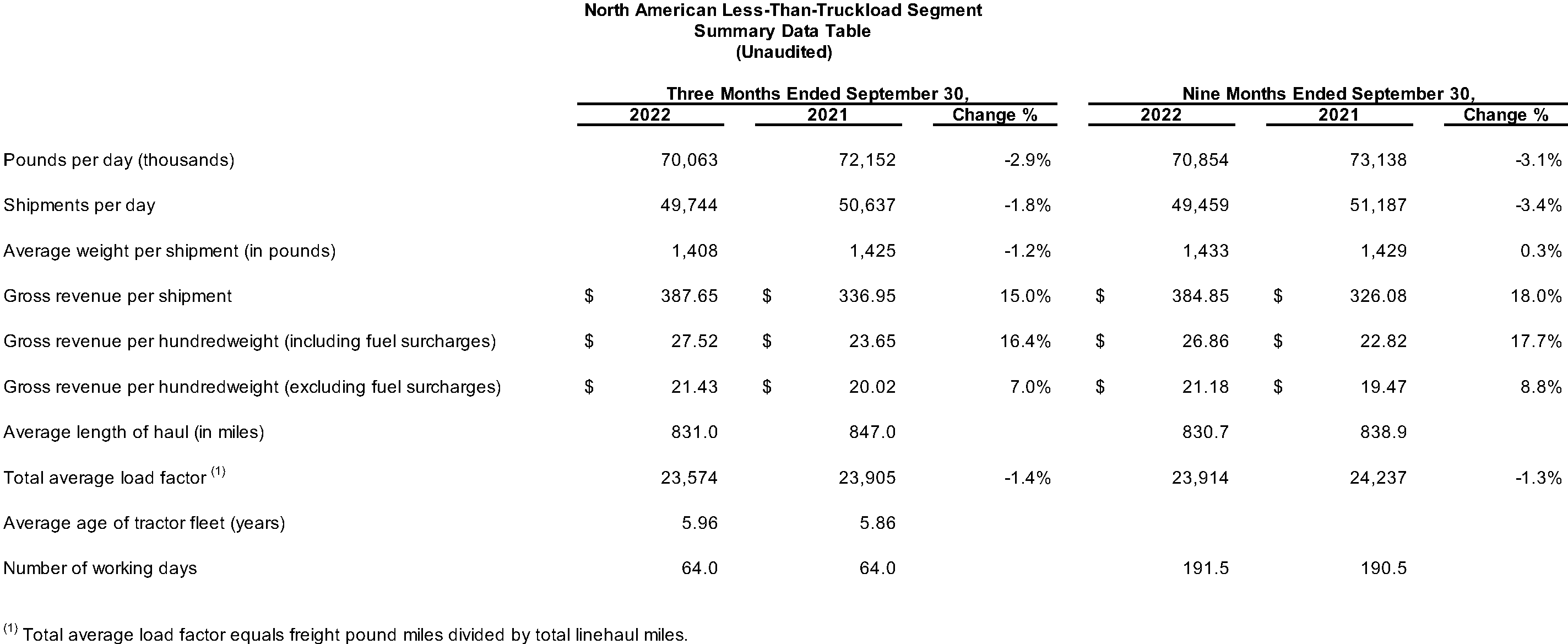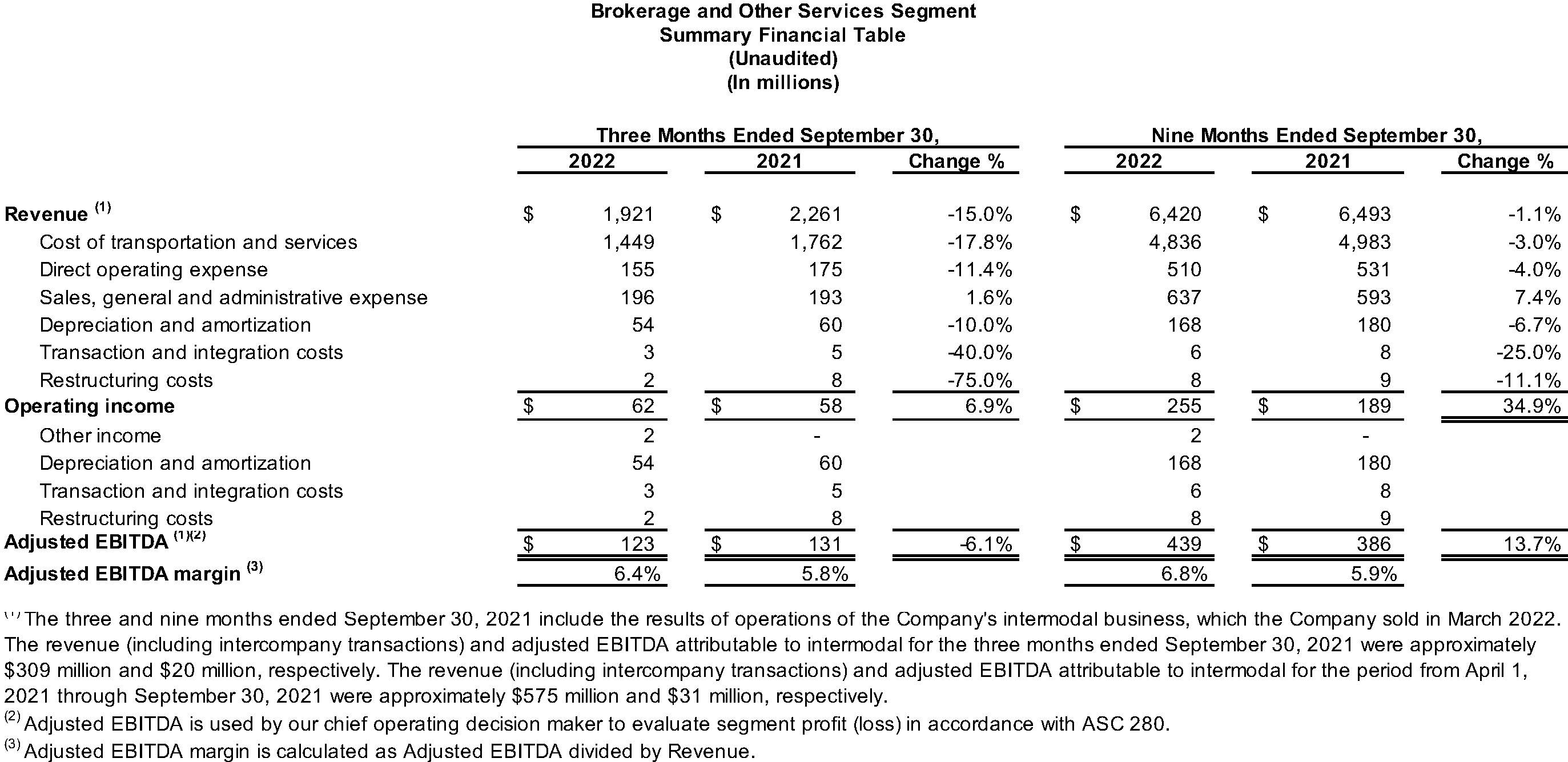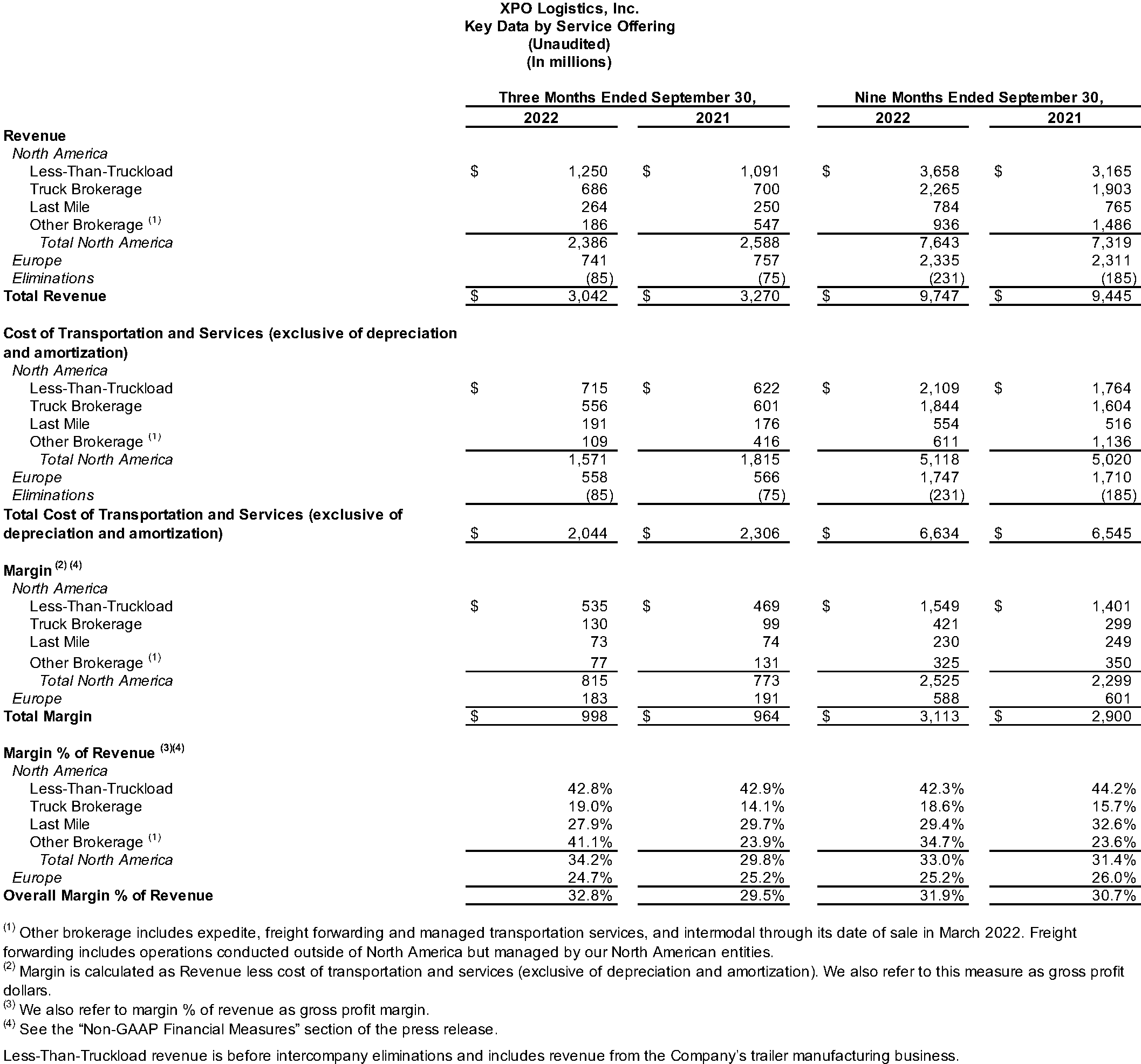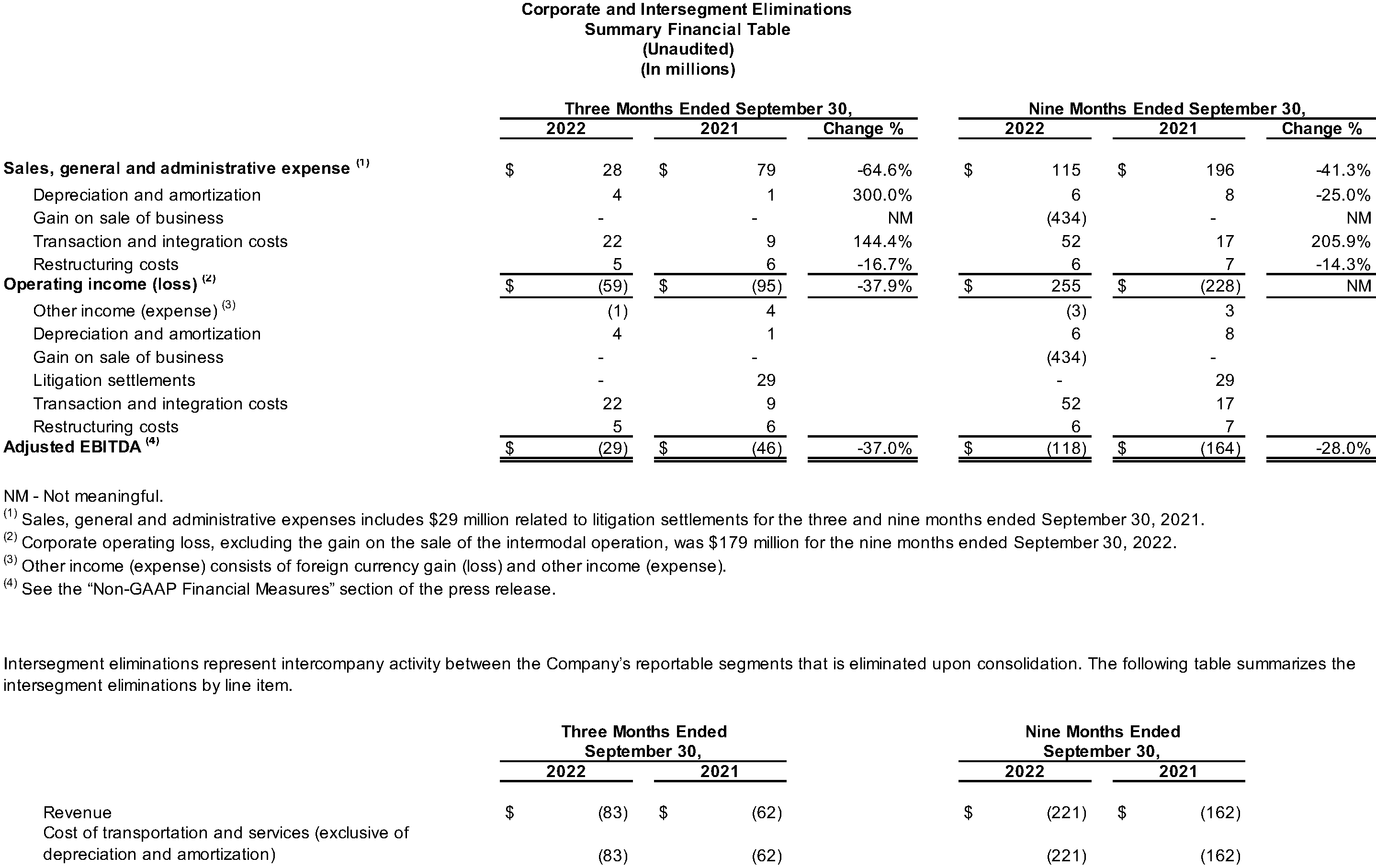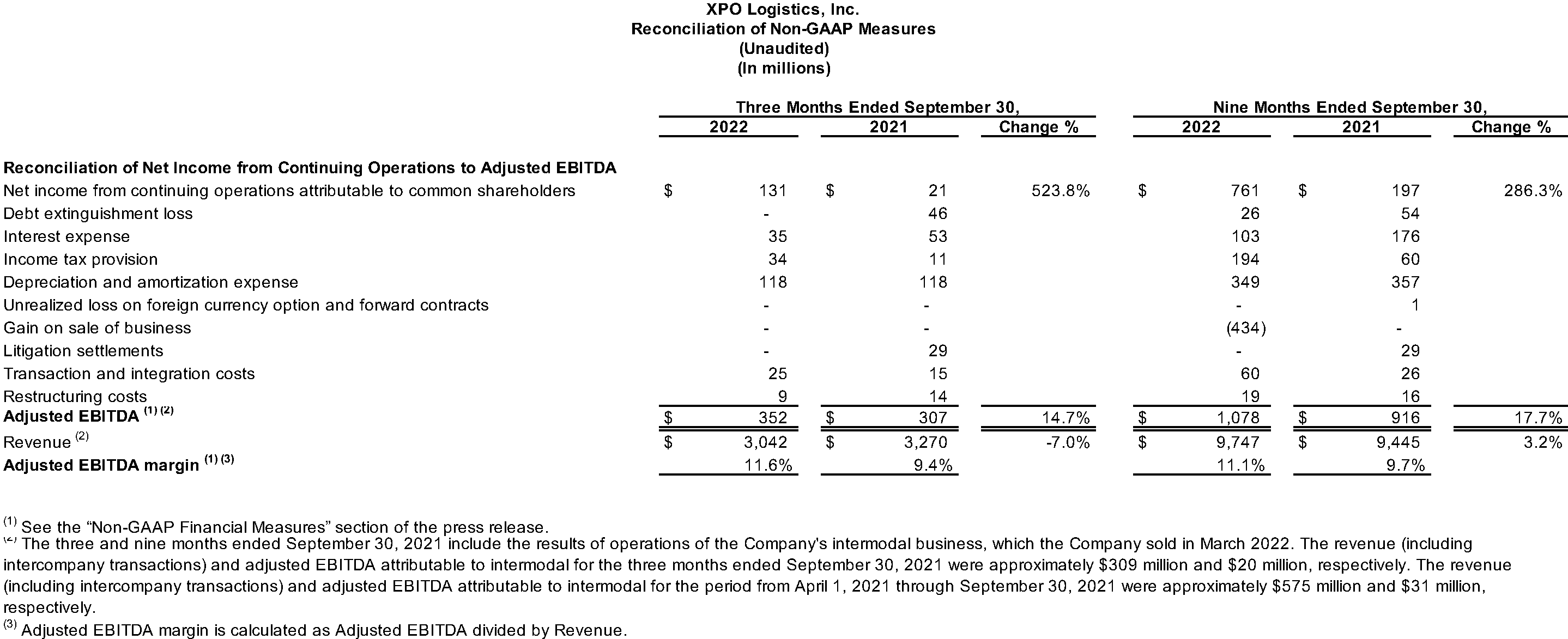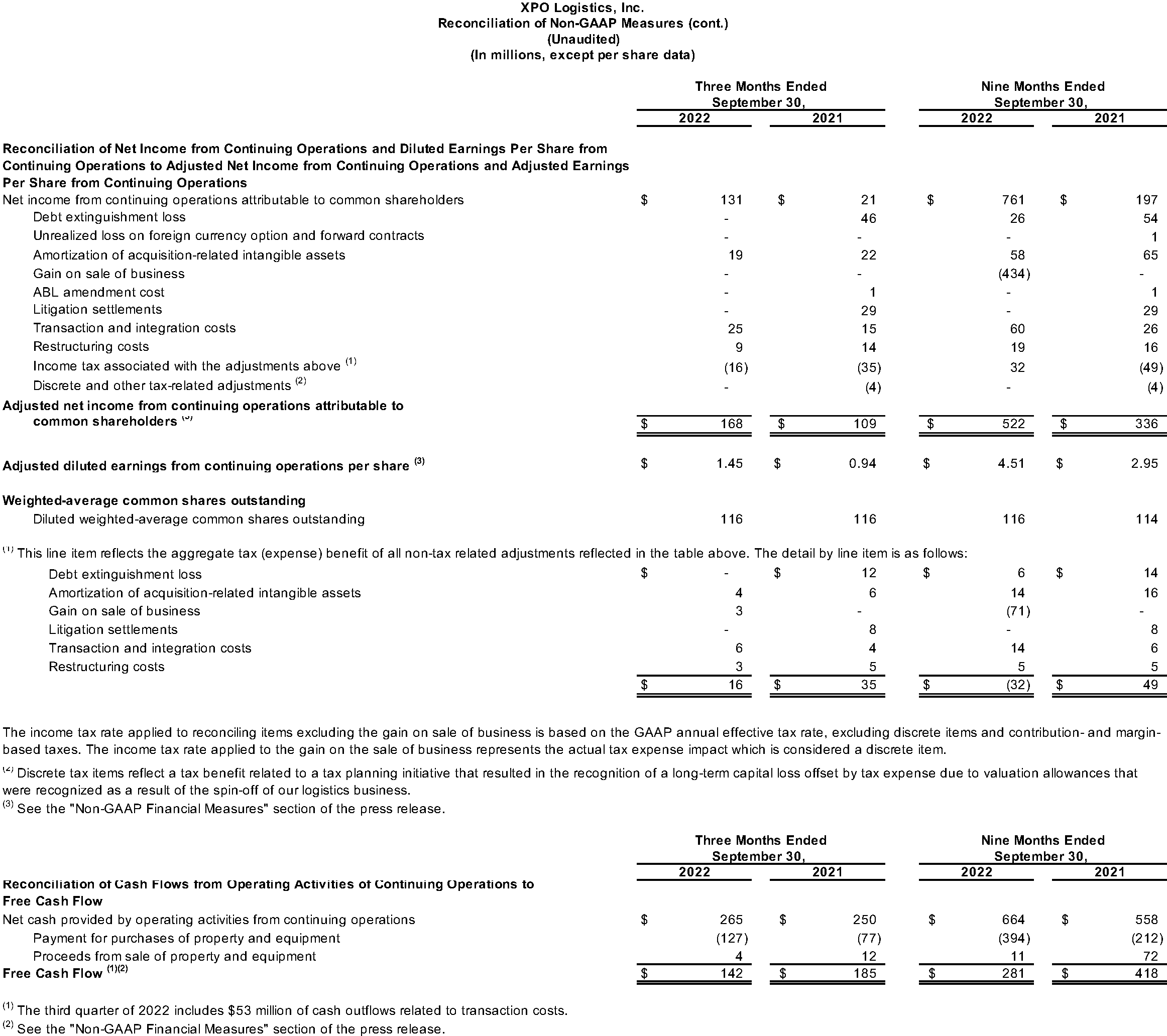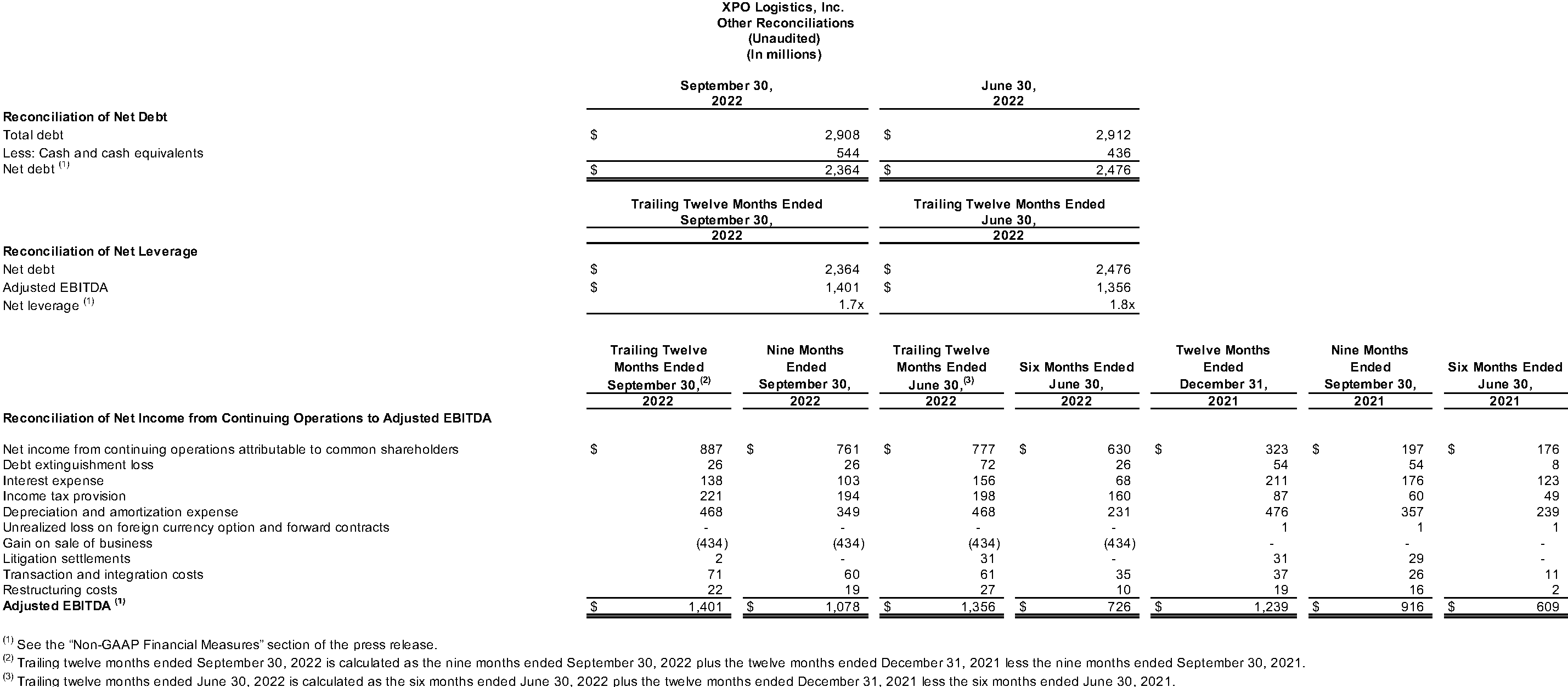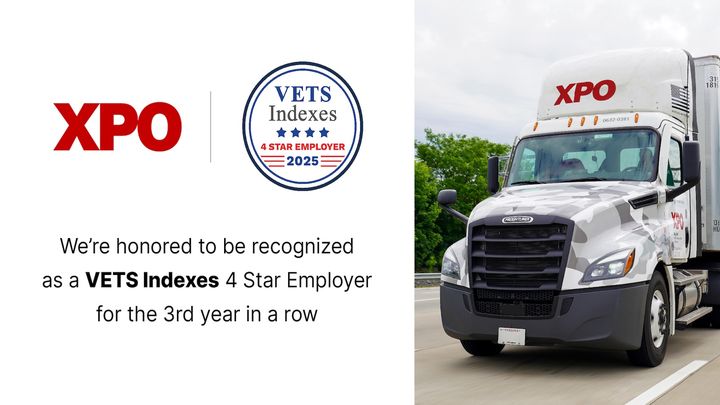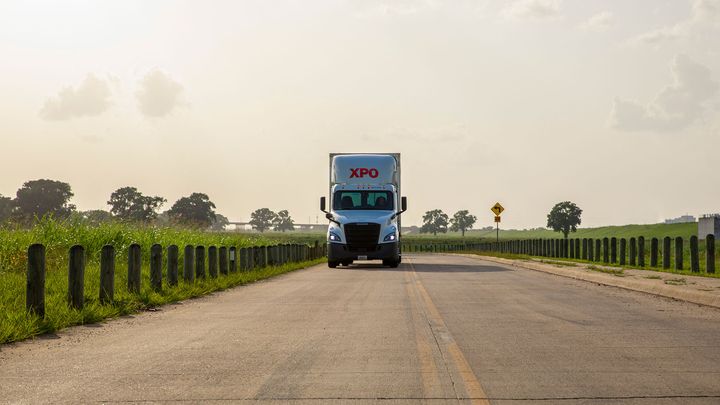XPO Announces Third Quarter 2022 Results
Delivered third quarter record operating income, up 65% year-over-year
Improved tonnage in North American LTL each month through third quarter; tonnage inflected positive year-over-year in September
Grew North American truck brokerage volume year-over-year by 9%
XPO (NYSE: XPO) today announced its financial results for the third quarter 2022.
Revenue was $3.04 billion for the third quarter, compared with $3.27 billion for the same period in 2021. Excluding third quarter 2021 revenue from the company’s intermodal operation, which was sold in March 2022, third quarter 2022 revenue increased year-over-year by 3%.
Net income from continuing operations attributable to common shareholders was $131 million for the third quarter, compared with $21 million for the same period in 2021. Operating income was $185 million for the third quarter, compared with $112 million for the same period in 2021. Diluted earnings from continuing operations per share was $1.13 for the third quarter, compared with $0.19 for the same period in 2021.
Adjusted net income from continuing operations attributable to common shareholders, a non-GAAP financial measure, increased to $168 million for the third quarter, compared with $109 million for the same period in 2021. Adjusted diluted earnings from continuing operations per share, a non-GAAP financial measure, was $1.45 for the third quarter, compared with $0.94 for the same period in 2021.
Adjusted earnings before interest, taxes, depreciation and amortization (“adjusted EBITDA”), a non-GAAP financial measure, increased to $352 million for the third quarter, compared with $307 million for the same period in 2021.
For the third quarter 2022, the company generated $265 million of cash flow from operating activities and $142 million of free cash flow, a non-GAAP financial measure.
Reconciliations of non-GAAP financial measures used in this release are provided in the attached financial tables.
2022 Less-Than-Truckload (LTL) Financial Targets
For the full year 2022, for the North American LTL business, the company reaffirmed the following targets, both previously announced:
- At least $1 billion of full year adjusted EBITDA, including gains on sales of real estate of up to $50 million in the fourth quarter; and
- Year-over-year improvement of 50 to 100 basis points in adjusted operating ratio for the full year, including at least 120 basis points of improvement in the fourth quarter, excluding gains on sales of real estate.
CEO Comments
Brad Jacobs, chairman and chief executive officer of XPO, said, “Our record results in the third quarter demonstrate how strongly our North American businesses are positioned for growth as standalone companies. Both LTL and truck brokerage outperformed on key metrics leading into tomorrow’s spin-off, and will thrive under the leadership of Mario Harik as CEO of XPO, and Drew Wilkerson as CEO of RXO.
“Our plan for LTL 2.0 is showing tangible results. We reported third quarter LTL records for revenue and adjusted EBITDA. Our year-over-year tonnage accelerated every month through the quarter and inflected positive in September, with more improvement in October. Importantly, our third quarter tonnage trend outperformed typical seasonality, bucking industry trends.
“Our truck brokerage business achieved a gross profit margin of 19% in the third quarter, with gross profit dollars up dramatically year-over-year by 31%. We grew volume by 9%, decisively outpacing the industry.”
Jacobs continued, “I thank our shareholders for their long-standing support of the company we began building in 2011 and the new public companies we’ve created. XPO was the seventh best-performing stock of the last decade on the Fortune 500, and I’m proud that our evolution into XPO, RXO and GXO is serving the best interests of our shareholders.”
Results by Business Segment

- North American Less-Than-Truckload (LTL): The segment generated revenue of $1.2 billion for the third quarter 2022, compared with $1.1 billion for the same period in 2021. The year-over-year growth in revenue primarily reflects an increase in yield.
Operating income for the segment was $182 million for the third quarter 2022, compared with $149 million for the same period in 2021. Adjusted EBITDA for the third quarter 2022, which had no gains on real estate sales, was $258 million; compared with adjusted EBITDA for the third quarter 2021 of $222 million, which included approximately $5 million in gains on real estate sales. Excluding real estate sales in both periods, LTL adjusted EBITDA grew by 19%.
Third quarter 2022 operating ratio was 85.0%. Adjusted operating ratio, excluding gains on real estate sales, improved 160 basis points year-over-year to 82.8%.
- Brokerage and Other Services: Revenue for the segment was $1.92 billion for the third quarter 2022, compared with $2.26 billion for the same period in 2021. The decrease in revenue was due primarily to the sale of the North American intermodal operation in March 2022, which impacted revenue by $309 million (including intercompany transactions).
Operating income for the segment was $62 million for the third quarter 2022, compared with $58 million for the same period in 2021. Adjusted EBITDA was $123 million for the third quarter 2022, compared with $131 million for the same period in 2021. The year-over-year decrease in adjusted EBITDA was due primarily to the sale of the intermodal operation.
Truck brokerage revenue in North America decreased 2% to $686 million for the third quarter 2022, compared with $700 million for the same period in 2021. The decrease in revenue was primarily driven by lower truckload pricing in the spot market, partially offset by a year-over-year increase in North American truck brokerage volume, facilitated by the company’s digital brokerage platform.
- Corporate: Corporate expense was $59 million for the third quarter 2022, compared with $95 million for the same period in 2021. Corporate adjusted EBITDA was an expense of $29 million for the third quarter 2022, compared with $46 million for the same period in 2021.
Liquidity and Deleveraging
As of September 30, 2022, the company had $1.54 billion of total liquidity, including $544 million of cash and cash equivalents and approximately $1 billion of available borrowing capacity. The net leverage ratio as of September 30, 2022 was 1.7x, down from 1.8x as of June 30, 2022, and within the company’s target range of 1.0x – 2.0x.
Net leverage ratio is calculated as net debt of $2.36 billion, divided by adjusted EBITDA of $1.40 billion for the trailing 12 months ended September 30, 2022.
Conference Call
The company will hold a conference call on Monday, October 31, 2022, at 8:30 a.m. Eastern Time. Participants can call toll-free (from US/Canada) 1-877-269-7756; international callers dial +1-201-689-7817. A live webcast of the conference will be available on the investor relations area of the company’s website, xpo.com/investors. The conference will be archived until December 1, 2022. To access the replay by phone, call toll-free (from US/Canada) 1-877-660-6853; international callers dial +1-201-612-7415. Use participant passcode 13733483.
About XPO
XPO (NYSE: XPO) is a leading provider of freight transportation services, primarily less-than-truckload (LTL) and truck brokerage. XPO uses its proprietary technology, including its digital freight marketplace, to move goods efficiently through supply chains. Following the planned spin-off of the RXO brokered transportation platform on November 1, 2022, XPO’s sole business in North America will be one of the largest providers of asset-based LTL transportation, and together with its business in Europe, XPO will serve approximately 43,000 shippers with 564 locations and 38,000 employees. The company is headquartered in Greenwich, Conn., USA. Visit xpo.com for more information, and connect with XPO on Facebook, Twitter, LinkedIn, Instagram and YouTube.
About the RXO spin-off
XPO intends to spin off its tech-enabled brokered transportation platform in North America as an independent publicly traded company (NYSE: RXO) on November 1, 2022. RXO’s best-in-class brokerage offering will provide customers with access to massive truckload capacity, cutting-edge technology and complementary brokered services for managed transportation, last mile and freight forwarding. Visit rxo.com for more information.
Non-GAAP Financial Measures
As required by the rules of the Securities and Exchange Commission (“SEC”), we provide reconciliations of the non-GAAP financial measures contained in this press release to the most directly comparable measure under GAAP, which are set forth in the financial tables attached to this press release.
XPO’s non-GAAP financial measures in this press release include: adjusted earnings before interest, taxes, depreciation and amortization (“adjusted EBITDA”) on a consolidated basis and for corporate and intersegment eliminations; adjusted EBITDA margin on a consolidated basis; adjusted net income from continuing operations attributable to common shareholders and adjusted diluted earnings from continuing operations per share (“adjusted EPS”); margin (revenue less cost of transportation and services (exclusive of depreciation and amortization)) and margin as a percentage of revenue (margin % of revenue) by service offering; free cash flows; adjusted operating income (including and excluding gains on real estate transactions) for our North American less-than-truckload segment; adjusted operating ratio (including and excluding gains on real estate transactions) for our North American less-than-truckload segment; adjusted EBITDA excluding gains on real estate transactions for our North American less-than-truckload segment; net leverage and net debt. We also refer to (i) margin as gross profit dollars and (ii) margin as a percentage of revenue (margin % of revenue) as gross profit margin in this release.
We believe that the above adjusted financial measures facilitate analysis of our ongoing business operations because they exclude items that may not be reflective of, or are unrelated to, XPO and its business segments’ core operating performance, and may assist investors with comparisons to prior periods and assessing trends in our underlying businesses. Other companies may calculate these non-GAAP financial measures differently, and therefore our measures may not be comparable to similarly titled measures of other companies. These non-GAAP financial measures should only be used as supplemental measures of our operating performance.
Adjusted EBITDA, adjusted EBITDA margin, adjusted net income from continuing operations attributable to common shareholders and adjusted EPS include adjustments for transaction and integration costs, as well as restructuring costs and other adjustments as set forth in the attached tables. Transaction and integration adjustments are generally incremental costs that result from an actual or planned acquisition, divestiture or spin-off and may include transaction costs, consulting fees, retention awards, and internal salaries and wages (to the extent the individuals are assigned full-time to integration and transformation activities) and certain costs related to integrating and converging IT systems. Restructuring costs primarily relate to severance costs associated with business optimization initiatives. Management uses these non-GAAP financial measures in making financial, operating and planning decisions and evaluating XPO’s and each business segment’s ongoing performance.
We believe that free cash flow is an important measure of our ability to repay maturing debt or fund other uses of capital that we believe will enhance stockholder value. We calculate free cash flow as net cash provided by operating activities from continuing operations, less payment for purchases of property and equipment plus proceeds from sale of property and equipment. We believe that adjusted EBITDA and adjusted EBITDA margin improve comparability from period to period by removing the impact of our capital structure (interest and financing expenses), asset base (depreciation and amortization), litigation settlements, tax impacts and other adjustments as set out in the attached tables that management has determined are not reflective of core operating activities and thereby assist investors with assessing trends in our underlying businesses. We believe that adjusted net income from continuing operations attributable to common shareholders and adjusted EPS improve the comparability of our operating results from period to period by removing the impact of certain costs and gains that management has determined are not reflective of our core operating activities, including amortization of acquisition-related intangible assets, transaction and integration costs, restructuring costs and other adjustments as set out in the attached tables. We believe that margin (revenue less cost of transportation and services (exclusive of depreciation and amortization)) and margin as a percentage of revenue (margin % of revenue) improve the comparability of our operating results from period to period by removing the cost of transportation and services, in particular the cost of fuel, incurred in the reporting period as set out in the attached tables. We believe that adjusted operating income and adjusted operating ratio improve the comparability of our operating results from period to period by (i) removing the impact of certain transaction and integration costs and restructuring costs, as well as amortization expenses and (ii) including the impact of pension income incurred in the reporting period as set out in the attached tables. We believe that net leverage and net debt are important measures of our overall liquidity position and are calculated by removing cash and cash equivalents from our reported total debt and reporting net debt as a ratio of our trailing twelve-month reported adjusted EBITDA.
With respect to our financial targets for full year 2022 and fourth quarter 2022 North American LTL adjusted operating ratio, a reconciliation of these non-GAAP measures to the corresponding GAAP measures is not available without unreasonable effort due to the variability and complexity of the reconciling items described above that we exclude from these non-GAAP target measures. The variability of these items may have a significant impact on our future GAAP financial results and, as a result, we are unable to prepare the forward-looking statement of income and statement of cash flows prepared in accordance with GAAP that would be required to produce such a reconciliation.
Forward-looking Statements
This release includes forward-looking statements within the meaning of Section 27A of the Securities Act of 1933, as amended, and Section 21E of the Securities Exchange Act of 1934, as amended, including statements relating to the planned spin-off of our tech-enabled brokered services platform, the expected timing and anticipated benefits of the spin-off; our 2022 financial target of at least $1 billion of adjusted EBITDA in the North American LTL segment, including gains on sales of real estate of up to $50 million in the fourth quarter 2022; and our 2022 financial target of year-over-year improvement of 50 to 100 basis points in North American LTL adjusted operating ratio, including at least 120 basis points of improvement in fourth quarter 2022 (excluding gains on sales of real estate). All statements other than statements of historical fact are, or may be deemed to be, forward-looking statements. In some cases, forward-looking statements can be identified by the use of forward-looking terms such as “anticipate,” “estimate,” “believe,” “continue,” “could,” “intend,” “may,” “plan,” “potential,” “predict,” “should,” “will,” “expect,” “objective,” “projection,” “forecast,” “goal,” “guidance,” “outlook,” “effort,” “target,” “trajectory” or the negative of these terms or other comparable terms. However, the absence of these words does not mean that the statements are not forward-looking. These forward-looking statements are based on certain assumptions and analyses made by us in light of our experience and our perception of historical trends, current conditions and expected future developments, as well as other factors we believe are appropriate in the circumstances.
These forward-looking statements are subject to known and unknown risks, uncertainties and assumptions that may cause actual results, levels of activity, performance or achievements to be materially different from any future results, levels of activity, performance or achievements expressed or implied by such forward-looking statements. Factors that might cause or contribute to a material difference include our ability to effect the spin-off of our tech-enabled brokered services platform and meet the related conditions of the spin-off, our ability to complete the divestiture of our European business, the expected timing of the completion of these transactions and the terms of the transactions, our ability to achieve the expected benefits of the transactions, our ability to retain and attract key personnel for the separate businesses, the risks discussed in our filings with the SEC, and the following: economic conditions generally; the severity, magnitude, duration and aftereffects of the COVID-19 pandemic, including supply chain disruptions due to plant and port shutdowns and transportation delays, the global shortage of certain components such as semiconductor chips, strains on production or extraction of raw materials, cost inflation and labor and equipment shortages, which may lower levels of service, including the timeliness, productivity and quality of service, and government responses to these factors; our ability to align our investments in capital assets, including equipment, service centers, and warehouses and other network facilities, to our customers’ demands; our ability to implement our cost and revenue initiatives; the effectiveness of our action plan, and other management actions, to improve our North American LTL business; our ability to benefit from a sale, spin-off or other divestiture of one or more business units, and the impact of anticipated material compensation and other expenses, including expenses related to the acceleration of equity awards, to be incurred in connection with a substantial disposition; our ability to successfully integrate and realize anticipated synergies, cost savings and profit improvement opportunities with respect to acquired companies; goodwill impairment, including in connection with a business unit sale, spin-off or other divestiture; matters related to our intellectual property rights; fluctuations in currency exchange rates; fuel price and fuel surcharge changes; natural disasters, terrorist attacks, wars or similar incidents, including the conflict between Russia and Ukraine and increased tensions between Taiwan and China; risks and uncertainties regarding the expected benefits of a future spin-off of a business unit, the impact of a future spin-off of a business unit on the size and business diversity of our company; the ability of the spin-off of a business unit to qualify for tax-free treatment for U.S. federal income tax purposes; our ability to develop and implement suitable information technology systems and prevent failures in or breaches of such systems; our indebtedness; our ability to raise debt and equity capital; fluctuations in fixed and floating interest rates; our ability to maintain positive relationships with our network of third-party transportation providers; our ability to attract and retain qualified drivers; labor matters, including potential labor disputes between railroads and their union employees and our ability to manage our subcontractors, and risks associated with labor disputes at our customers and efforts by labor organizations to organize our employees and independent contractors; litigation, including litigation related to alleged misclassification of independent contractors and securities class actions; risks associated with our self-insured claims; risks associated with defined benefit plans for our current and former employees; the impact of potential sales of common stock by our chairman; governmental regulation, including trade compliance laws, as well as changes in international trade policies, sanctions and tax regimes; governmental or political actions, including the United Kingdom’s exit from the European Union; and competition and pricing pressures.
All forward-looking statements set forth in this release are qualified by these cautionary statements and there can be no assurance that the actual results or developments anticipated by us will be realized or, even if substantially realized, that they will have the expected consequences to or effects on us or our business or operations. Forward-looking statements set forth in this release speak only as of the date hereof, and we do not undertake any obligation to update forward-looking statements to reflect subsequent events or circumstances, changes in expectations or the occurrence of unanticipated events, except to the extent required by law.
Where required by law, no binding decision will be made with respect to the divestiture of the European business other than in compliance with applicable employee information and consultation requirements.
